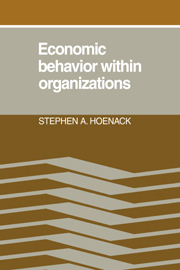Book contents
- Frontmatter
- Contents
- Preface
- 1 Introduction
- 2 Definitions and determinants of employees' discretion over an organization's resources and production
- 3 Employees' resource diversions and employers' imposition of resource responsibility
- 4 Short-run resource allocation under fixed budgets
- 5 Short-run resource allocation in response to demand: the cases of an employee, a private corporation, and a private nonprofit organization
- 6 Legislative demand and short-run price and output of the public organization
- 7 Employees' investment behavior and implications for suborganization
- 8 Equilibrium behavior of public and private organizations in the first long run
- 9 The demand and supply of nonmarket resource allocation
- 10 A brief summary and proposed directions for further work
- Notes
- References
- Core definitions
- Index
10 - A brief summary and proposed directions for further work
Published online by Cambridge University Press: 05 November 2011
- Frontmatter
- Contents
- Preface
- 1 Introduction
- 2 Definitions and determinants of employees' discretion over an organization's resources and production
- 3 Employees' resource diversions and employers' imposition of resource responsibility
- 4 Short-run resource allocation under fixed budgets
- 5 Short-run resource allocation in response to demand: the cases of an employee, a private corporation, and a private nonprofit organization
- 6 Legislative demand and short-run price and output of the public organization
- 7 Employees' investment behavior and implications for suborganization
- 8 Equilibrium behavior of public and private organizations in the first long run
- 9 The demand and supply of nonmarket resource allocation
- 10 A brief summary and proposed directions for further work
- Notes
- References
- Core definitions
- Index
Summary
This book's purpose has been to extend economic analysis to the behavior of an organization's individual employees. We have seen that, as a result, hypotheses can be derived about an organization's internal resource allocation and its supply behavior for short-run and long-run periods. Given an organization's production functions and employees' information cost advantages, it is possible to analyze the extent of employees' discretion over resource allocation and the types of constraints employers place on employees. The degree to which employees can use resources delegated to them to pursue their personal goals can be determined, and the responsiveness of the organization's internal economy to employees' welfare as well as to external economic forces can be established. Within this internal economy the range of derivable hypotheses about supplies, demands, costs, and investment behavior is approximately comparable to the range of existing hypotheses about these variables when organizations are taken as the smallest unit of analysis.
In the short run, where the effects of current investments are not considered, hypotheses about resource allocation have been derived for the cases where overall value and specific responsibility are imposed. We found that when an employee under overall value responsibility derives utility at the margin from personal uses of any of the resources delegated and attributed to him, he infers his employer's marginal value of each of these resources and, given his information about production possibilities, he allocates resources efficiently within his production domain according to these values.
- Type
- Chapter
- Information
- Economic Behaviour within Organizations , pp. 248 - 256Publisher: Cambridge University PressPrint publication year: 1983



